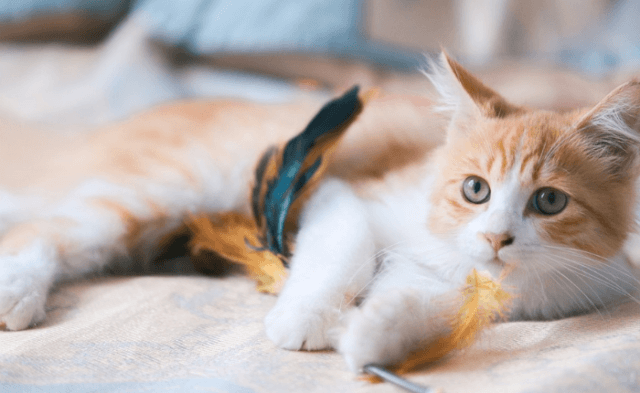This excerpt from PETA President Ingrid Newkirk’s book 250 Vital Things Your Cat Wants You to Know is just a sample of the many fascinating tips, tricks, and stories you’ll find to keep your feline pals healthy and happy.
If ever domesticated cats manage to get a Bill of Basic Rights through Congress—and I wouldn’t put it past them to do so one day—the right to decent healthcare could top the list of their entitlements. It would appear directly above a cat’s inalienable right not to be moved from your lap, even though he has somehow been magically transformed into a 50-pound lump that has cut off all circulation in your legs.
Who can concentrate on love or pretty much anything else when they feel awful? You know what I mean if you’ve ever tried to have a conversation with someone suffering from a migraine. They are utterly incapable of concentrating on anything other than their burning desire to have you stop talking and go somewhere else. Your cat’s the same way.
Perhaps one of the worst things that can happen to a cat besides falling asleep in the clothes dryer (yes, this happens) is for no one to notice that he has developed a physical problem. It’s hard to imagine cats as the strong, silent type, given that they can yowl up a storm if someone steps on a body part. However, like most wild or fairly newly domesticated beings, who are aware that predators put you on their dance card if you announce your vulnerability, they tend to clam up rather than cry out when they are in a really bad way.

Sometimes serious illness can escape even the most conscientious souls. When you hear yourself say, “Isn’t he well-behaved today?” or “Doesn’t that cat sleep a lot!” or “Boy, he doesn’t usually do that!” you could be noticing that your cat is run-down, weak, not feeling very well, unable to move about comfortably, or otherwise in distress. Any change in a cat’s pattern of behavior or mood merits some thought and a closer look right away.
I recommend doing the following every day (not because you really need to do it that often but because your cat will love it):
- Run your hand smoothly from stem to stern along Kitty’s body, feeling gently for lumps and bumps, seeing if your cat appears sensitive to the touch anywhere, and parting the hair to check for fleas, hair loss, an ear infection, you name it. This is the kitty equivalent of getting a back rub every day and will bond your cat to you like glue.
- Look into your cat’s eyes. Don’t forget to blink adoringly or your cat will think you have gone off the deep end. Are the eyes weepy? Is the skin inside the eye at the inner corner covering part of the eye, rather than being almost imperceptible and flat? That is your cat’s nictitating membrane, and it may be trying to tell you that Kitty is under the weather and that further investigation is in order.
- Very gently pull back the skin around Kitty’s gums (while rubbing his face for fun) and see how those teeth are doing. Do they need cleaning? (If so, see chapter on mouth health.) If the gums are white or very pale, your cat could have parasites or be anemic for some other reason.
- Sniff Kitty’s breath. Is that home cooking, or is something rotten?
- Sneak a peek under Kitty’s tail. This is a delicate maneuver that can cause deep, lasting offense, so take it easy. It may work to incorporate the under-tail inspection into some serious rump scratching, which will make your cat raise his tail. Is everything clean and shipshape? Or are there surprises, e.g., a prolapsed rectum (the skin has popped out and is distended) or the sort of untidiness that can mean parasites or an upset tummy?
- Squeeze each toe very, very gently, until the nails come out and you can look for breakages or abnormalities.
- Look (and smell) inside ears. If you see gunk, put a tiny bit of mineral oil on a cotton swab and wipe gently. If those black dots move or jump, you’ll need ear mite medicine. These mites particularly annoy the owner of the ear. We know this because a human researcher actually placed cat ear mites in his own ears just to see how things went. He woke up with a start at 3 a.m. every morning as the mites got an early and vigorous start to their day! To deal with them, you will have to dig all around inside your cat’s cavernous, convoluted ears extremely gently, and that is a big job. Infection greets your nose with a little zing and requires analysis before a remedy can be chosen. If your cat digs in an ear or two or shakes his head a lot, take that as a sign that there is a problem that deserves attention.
- Rub your fingers lightly under and between your cat’s paw pads in case a Spanish doubloon or burr is uncomfortably lodged there and could lead to infection.
- Look at Kitty’s hair coat. See if it is shiny (not greasy, which is a sign of ill health) and has elasticity, i.e., if you take up a fold of skin on Kitty’s back and then let go, it knows where it is supposed to be and springs right back where it belongs. If the skin “sits there” or very slowly returns to take its place as part of the greater cat body, your cat may be dehydrated. Is that automatic water dispenser clogged (throw it out anyway in favor of a stainless steel bowl you can clean and fill daily with fresh water), or could your cat be suffering from diarrhea? If the coat is dull, perhaps a stool sample should be dropped off at the vet’s. If the coat is dry, perhaps your angel’s diet would benefit from more fresh, steamed vegetables (see chapter 16) and a drop of vegetable oil, like olive oil. Bathing a cat’s outside bits will not restore a cat’s inside bits, so look for the cause before choosing the cure.
- Brush away excess hair with any effective brush from a pet supply store or catalog. Most cats prefer plastic to metal—there’s something scary about steel. Perhaps it reminds them of ships. If you don’t brush, cats can ingest wads of hair when they lick their coats clean. Hairballs may make good material for standup comics, but they aren’t digestible and can clog up a cat’s innards, causing nasty, knotty problems. Here’s one sign of them: Your cat stretches his neck out, crouches low to the ground, and coughs, usually with little to no result. Your vet can give you a malty-tasting lubricant that will help or possibly Miralax, but routine brushing and a good diet works just as well for most cats.





